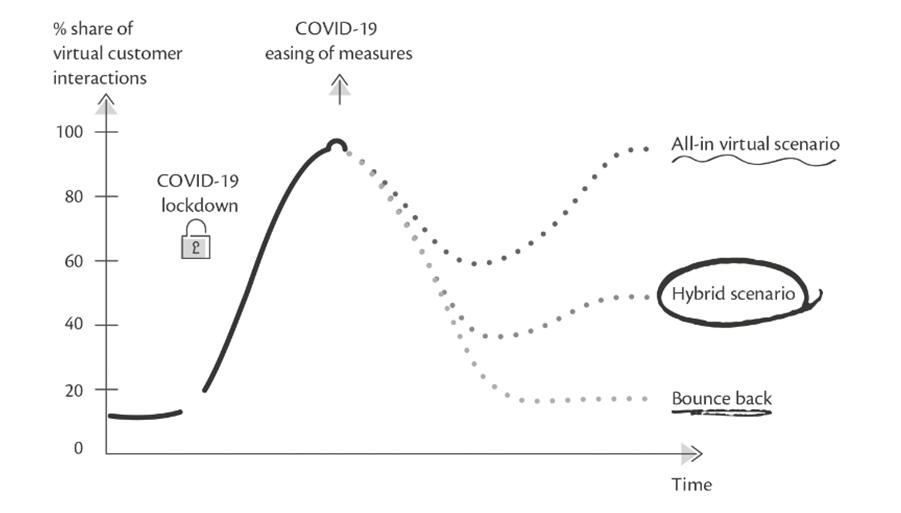Yhä useampi nuori Suomessa kokee yksinäisyyttä, ulkopuolisuutta ja eristäytyneisyyttä. Tähän ongelmaan pyritään puuttumaan NOPPA-hankkeella, jossa osallisuutta lisätään pelillistämisen avulla. …
Tekijät | Authors

New practices have emerged for virtual B2B sales meetings
Since March 2020, B2B customer sales meetings have faced major changes, as the sudden Covid-19 pandemic caused face to face meetings to move into a fully virtual world. Customers as well as salespeople must have learned new ways to work together and communicate in a virtual environment. The change has affected the customer experience, the purchasing process and enabled different practices between both the customer and the salespeople.
New practices for virtual sales meetings have emerged between companies. The cornerstones of a successful virtual sales meeting have been to provide the customer with an excellent customer-oriented virtual experience, the technical functionality of the virtual meeting, a clear structure and scheduling of the virtual sales meeting, and digital meeting practices. In a virtual sales meeting, it should be remembered that it is especially a matter of success in the interaction situation, and the traditional laws of face-to-face meetings may not work the same way. Therefore, every salesperson should think about the above cornerstones to create an excellent customer experience for the customer in virtual sales meetings.
Recent study conducted at Turku University of Applied Sciences investigated the experiences of B2B customers about virtual sales meetings. In the conducted MBA-level study, eight amount of business decision-makers and procurement managers were interviewed by utilizing semi-structured interviews. The Interviewees have met with salespeople during the Covid-19 pandemic only in virtual sales meetings. According to the results of the conducted study, the virtual sales meetings have been perceived as a positive experience after the initial challenges.
Careful preparation is the foundation of everything
The first impressions in virtual sales meetings were facelessness and mistrust. Today, however, customers expect everyone to have videos on, it builds trust and makes a virtual meeting much more personal. The most significant experience of virtual sales meetings has been the efficiency of the sales meeting in general. This has had an impact from the perspective of both the customer and the salesperson. Studies show that customers can meet more salespeople than before, and that unnecessary traveling is avoided.
Virtual sales meetings place a great responsibility and role on salespeople to succeed in a virtual meeting with a B2B customer. How should a salesperson prepare for a virtual B2B sales meeting so that the salesperson can engage the customer and succeed in the virtual sales meeting?
While every salesperson is aware of the importance of doing background work on the customer before a B2B sales meeting, it is crucial to succeed in a virtual sales meeting. The value of in-depth requires familiarity with the customer, knowledge of the industry, to whom you plan to sell, and insight into what solutions the customer may need. After this, a clear agenda must be prepared, a presentation tailored to the customer, and the material that the customer may wish to send in advance. The salesperson should also clarify for themselves what the goal of a virtual B2B sales meeting would be.
Virtual buying journey
The virtual B2B sales meeting itself is one of the most significant points of contact during the customer’s buying journey, therefore the virtual sales meeting must succeed in meeting the customer’s expectations and provide the customer with an excellent customer experience. It is very important for the salesperson to strive to create a positive atmosphere right at the beginning of the virtual sales meeting, as the traditional coffee moment of face-to-face meetings is missing. In addition to presenting participants and the company, customers also expect into market trends.
The salesperson must be able to create an excellent customer experience virtually.
The emergence of collaboration in a virtual sales meeting requires successful interaction between both the salesperson and the customer, similar to physical sales meeting. In a virtual sales meeting, it means giving all participants the opportunity to participate in the discussion and, in particular, involve everyone in the discussion. Consequently, it is the role of the salesperson to act as a chairman of the meeting. The salesperson must utilize his or her professional skills when identifying the customer’s needs and offering value-creating solutions to the customer’s business. In a virtual sales meeting, the importance of building trust and rapport should not be forgotten, although certain theories support that creating them is a little more difficult. Gestures and facial expressions are much more difficult to detect in the absence of a traditional face-to-face meeting.
At the end of the virtual sales meetings, we need to ensure mutual understanding, give time for feedback, agree on the following steps between both parties. For this entire virtual sales meeting to be meaningful to the customer, the meeting must stay on schedule.
The responsibility of salespeople is increasing, and the personality is having an even greater impact.
In a virtual sales meeting, everything can feel much flatter than in a face-to-face sales meeting, where the salesperson can correct the situation with their own personality or appearance. In a virtual sales meeting, the customer’s attention may be more focused on the presentation on the screen itself than on the salesperson themselves. From the point of view of the meaningfulness and interest of a virtual sales meeting, it is important to bring out your own personality as much as possible, so that the salesperson’s personal commitment and attitude towards the customer are conveyed to the customer.
The future expectations of B2B customers for virtual sales meetings
It is still very difficult to predict what kind of practices will arise between companies in terms of sales meetings when the new normal begins. What is clear, however, is that companies have already embraced digital practices and virtual interaction has been found to work well. In the hybrid model, companies take advantage of the benefits of both face-to-face and virtual meetings. According to Kvedare & Nymand (2021), 60% of customers and salespeople believe that virtual appointments replace face-to-face appointments in the hybrid scenario.

Figure 1. The hybrid sales model after Covid-19 (Kvedare & Nymand, 2021).
Research findings
The thesis studied the customers’ views regarding future appointments and what kind of practices there would be. The study found that customers think the hybrid model is very likely and virtual meetings will replace face-to-face meetings for the most part. This is particularly because almost all interviewees thought that the efficiency of buying would improve with virtual sales meetings. This is due to the fact that virtual sales meetings are efficient and virtual sales meetings are easy to organize. However, according to some decision-makers, all potential suppliers may be met face-to-face for the first time, after which discussions will continue with virtual sales meetings.
Based on the conducted research, it can be stated that customers have already adapted to the digital way of communicating with salespeople and companies. The changing B2B culture requires learning new things, creativity, and incorporating best practices into everyday life. Companies are likely to face various, surprising challenges in the future, but still, business development and collaboration must continue despite the situations. The Covid-19 pandemic continues to limit society, we can only hope that a new normal will be here as soon as possible. It remains to be seen how B2B interaction and collaboration will take shape. Companies should consider the best ideas and insights for virtual conferencing and digital practices, what to use after removing restrictions, and what to keep to in particular.
References:
Joronen, T. (2021). Customer experience in B2B virtual sales meeting. [Thesis, Turku University of Applied Sciences]. Retrieved from https://urn.fi/URN:NBN:fi:amk-2021121626481
Kvedare, M. & Nymand, C. M. (2021). The Virtual Sales Handbook: A Hands-on Approach to Engaging Customers. Wiley.
Rangarajan, D., Sharma, A., Lyngdoh, T. & Paesbrugghe B. (2021). Business-to-business selling in the post-COVID-19 era: Developing an adaptive sales force. Business horizons, 64(5), pp. 647-658. https://doi.org/10.1016/j.bushor.2021.02.030
Schultz, M., Shaby, D. & Springer, A. (2020). Virtual Selling: How to Build Relationships, Differentiate, and Win Sales Remotely. 35 Group Press.








